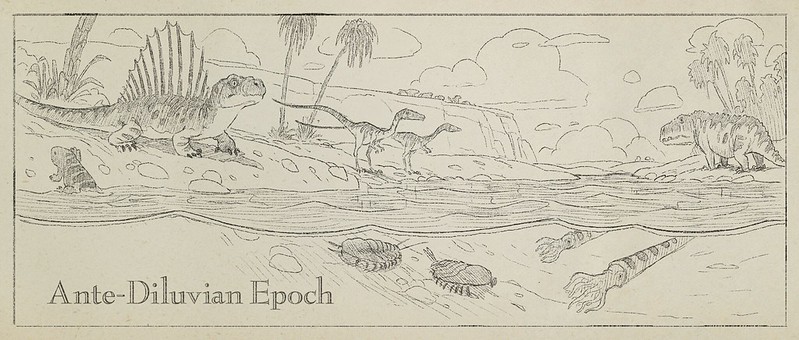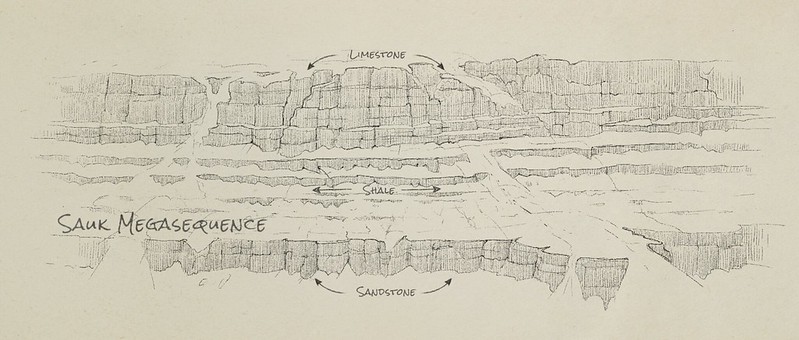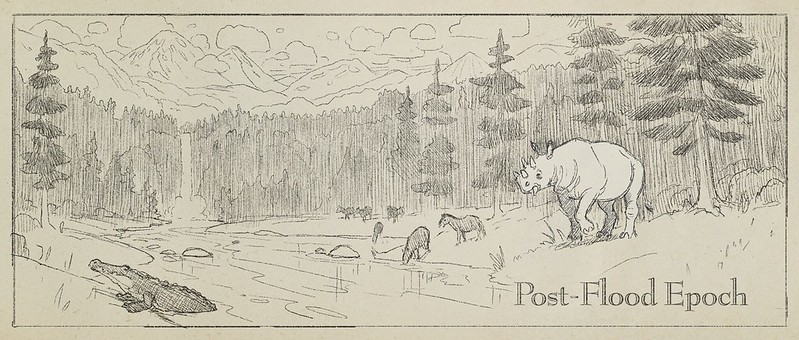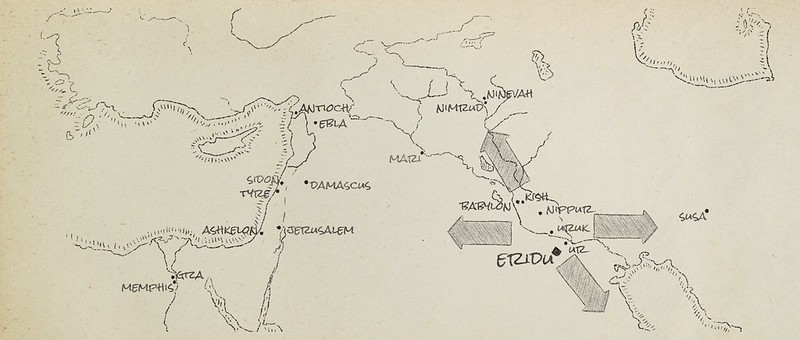EDITOR’S NOTE: The earth history timeline presented below represents the consensus among young-age scientists, but other variations of the Creation/Flood model do exist. Even if the basic outline presented here is ultimately true, the fine details are going to change as we continue to study the rocks, animals, plants, and celestial bodies we share the universe with. That is how science works! Nevertheless, the disagreements between different young-earth models have no significant bearing on the timescale or overall sequence of events recorded in Genesis 1-11.
Creation Epoch & Edenian Epoch


- With the origin of time itself, God created the heavens, earth, sea, and everything in them over the span of six day-night cycles (called Creation Week). Most creation scientists date this event to have occurred sometime between 6,000 and 10,000 years ago.
- Upon its initiation, planet Earth was a water-covered ball floating in space, with no visible land areas. This changed on the third day of Creation Week, when God gathered the waters into one place so that dry land would appear. The dry land was likely a supercontinent, rather than our modern continental arrangement.
- While life—as defined biblically—was not created until Day 5 and 6 of Creation Week, it seems that biological life—as defined in terms of modern science—was first created in the oceans in the form of bacterial colonies called stromatolites.
- Water draining off the uplifted continent(s) carried great quantities of sediment into the ocean basins, burying many stromatolite colonies and other microorganisms in the process.
- God created plants on Day 3 and He made animals on Day 5 and Day 6. Organisms were created according to their own, distinct major groups, or “kinds,” and did not evolve from a common ancestor over billions of years.
- The origin of humans was the last act of creation, with the bringing forth of Adam and Eve.
- It was only after Adam and Eve sinned that humans and certain kinds of animals became carnivorous. Before this point, they would have eaten nothing but plants.
Suggested Reading
- The History of Life: Creation Week
- The History of Life: Edenian Epoch
- Mature Creationism: Is God Lying?
Antediluvian Epoch

- God cursed everything within Adam’s dominion when he sinned. Death, disease, suffering, and carnivory play vital roles in the very functioning of the universe.
- Humans, other mammals and flowering plants, called angiosperms, are widespread today, but in the Antediluvian epoch, adjacent ecological communities segregated the various life forms. During this time, dinosaurs and other ancient reptiles ruled the land, while ferns and certain types of non-flowering plants, called gymnosperms, dominated the plant world. In the oceans, hot spring environments housed communities of mushroom-shaped stromatolites, and in the northern hemisphere, massive forests of lycopods floated on the ocean’s surface.
- Created kinds of living things were designed with the capacity to reproduce and multiply with the purpose of filling the Earth. As they filled new habitats, they would adapt and diversify, often generating new species.
- The Nephilim, born during this time, were the result unions between the “Sons of God” and the “Daughters of Men” (Genesis 6:1-4). Human wickedness and violence among man and beast became so prevalent throughout the Earth that God judged the planet with a global Flood. To escape the cataclysm to come, God instructed Noah to build an Ark so that he, his family, and representative pairs of every kind of air-breathing, land-dwelling animal could be spared.
Suggested Reading
Global Flood

- Most young-earth creationists date the Flood to have occurred sometime between 4,350 and 8,350 years ago.
- The Flood began on the 17th day of the second month of the 600th year of Noah’s life. On that day, magma upwelled from deep within the Earth and split the seafloor. The ocean water this magma came into contact with flashed into supersonic steam jets, which shot up into the atmosphere. This water came down again as torrential rain. As the floodwaters destroyed the dry land surface, they deposited thick packages of sediment layers and countless pre-Flood organisms they contain, which turned into fossils.
- The floodwaters peaked somewhere between the 40th and 150th day of the Flood, covering even the highest mountains of that time. By this point, every air-breathing, land-dwelling creature not aboard the Ark has perished (though populations of marine lifeforms persist beneath the waves).
- Mountaintops appear as the floodwaters gradually recede from off the land over the course of many months. During this time, plant life (e.g. the olive sapling) begins to grow and reclaim the Earth as more and more land is exposed above sea level. The Earth was declared dry on the first day of the first month of Noah’s 601st year.
Suggested Reading
- What’s So Great About the Great Unconformity?
- Catastrophic Plate Tectonics: A Biblical Flood Model
- The Role of Tsunamis in the Flood
Arphaxadian Epoch

- Following the Flood God blessed Noah and his sons, telling them to “Be fruitful, and multiply, and replenish the earth.” Noah and his family settled near Ararat for some time during which he “began to be a man of the soil”.
- Tectonic activity during the Flood left the world’s oceans substantially warmer than they are today. This essentially turned the planet into a giant greenhouse and generated high levels of rainfall.
- In the years following the Flood, animals and plants recolonized the Earth. Many of them were buried in localized, post-Flood natural disasters that declined in extent and intensity with the passage of centuries.
- Cooling oceans caused the early Arphaxadian climate to become cooler and drier than it had been before. This caused tropical and temperate forests to recede, with open woodlands and grasslands growing in their place. Species unable to cope with these changes in climate died out, but others thrived and diversified into a myriad of new species.
- Once the population had grown, the people migrated to the land of Shinar between the Tigris and Euphrates Rivers. Genesis 10:10 seems to say that Nimrod founded the city of Babel. Nimrod appears to have set himself up as a ruler in the region, and likely directed the building of the infamous “Tower of Babel”. Their motive was fame, to create a magnificent structure through which future generations would remember their legacy.
Paleolithic Age
- Also known as the Old Stone Age, it is during this period that mankind developed and used stone tools.
- God confused the languages of the builders, causing them to stop their construction. As a result, they journeyed away from the land of Shinar. As they encountered new environments the people rapidly diversified into a variety of people groups. Most of these populations died out over time, and by Abraham’s day people across the world looked identical to modern humans.
- Eventually, the climate cooled to the point that glaciers developed into ice sheets that radiated out across the northern latitudes and mountainous regions of the planet. This lowered sea levels worldwide, forming land bridges that facilitated the movement of animals and humans across different continents.
- The ice sheets achieved their maximum extent at Glacial Maximum. At this point, the oceans had cooled enough that evaporation and precipitation had leveled off, grinding the growth of ice sheets to a halt. Species like the woolly mammoth, bison, and horses had since adapted to thrive in a unique biome called the Mammoth Steppe that was widespread throughout the northern hemisphere at this time.
- The end of the Ice Age was characterized by the rapidly melting of ice sheets as the global average temperature increased. This resulted in large-scale flooding (e.g. Lake Missoula Flood) and rapid changes in climate. A minor extinction event occurred during this time that resulted in the demise of woolly mammoths and other Ice Age megafauna.
Suggested Reading
- The History of Life: Arphaxadian Epoch
- What was the World like when Noah stepped off the Ark?
- How Do Creationists Explain the Ice Age?
Patriarchal Period

Neolithic Age (~3298-2850 BC)
- Certain types of animals became domesticated. These included animals for meat, milk, and wool, such as sheep and goats (e.g. Genesis 29:7). Camels functioned as beasts of burden at least as early as 2000 BC.
- Some people groups had settled down, building fortified cities. Others, like the Patriarchs, were still nomadic, living in tents and moving from place to place.
Chalcolithic (Copper) Age (~2850–2500 BC)
- A significant distinction of this age is the discovery of metal smelting technology and the use of copper. Elaborate copper artifacts have survived from this period.
- The people of this age valued religion, as evidenced by the temples discovered at En-Gedi and Megiddo.
- Some biblical scholars place the Tower of Babel event in this period.
Bronze Age (~2500-1177 BC)
- By the Bronze Age, independent nations and ethnicities were firmly established. City-states developed and world powers emerged. In the near east, Egypt emerged as the most powerful nation in the south, while Mitanni ruled in the north.
- By this time, religious systems had also developed, and polytheism was common. In the land of Canaan, El and his consort, Asherah, were the chief gods among many lesser gods. Gods were localized, and when people traveled, they would often pay homage to the local gods at their destination. Abraham’s monotheism and his interactions with one God in various locations would have been quite unusual.
- By the time of Abraham, Isaac, and Jacob, the turbulent aftershocks of the global Flood had subsided. The climate likely continued to fluctuate to some extent, however, perhaps causing some of the famines recorded in Genesis (12:10; 26:1; 41:54).
- Many biblical accounts occur during this age: Abraham, Isaac, and Jacob established themselves in the land of Canaan (Genesis 12–35); Jacob and his family relocate to Egypt (Genesis 46–49); and Moses leads the Israelites back to the promised land (Exodus–Deuteronomy).
- Toward the end of the Bronze Age, Joshua led the Israelites in the conquest of Canaan (Joshua).




